Why Robotic Process Automation Is Having a Breakthrough Moment

In 2020, we’re going to see a dramatic uptake in a technology known as robotic process automation, or RPA. With RPA, software bots perform mundane business tasks such as processing employee payrolls faster and more accurately than people can, thus freeing up people to focus on more meaningful work. Research firm Garter says companies will spend $2.4 billion on RPA technology by 2022. Forrester says the market will grow to $2.9 billion by 2021.
Why is RPA growing? Because RPA is getting smarter thanks to artificial intelligence.
What Is RPA?
RPA lets organizations automate tasks as if a real person were doing them across applications and systems. RPA software interacts with legacy technologies the same way a person does, which means no complex system integration is needed. Think of RPA as trained robots who act as virtual workers. They execute rules-based information processes, thus improving accuracy and efficiency.
According to Gartner, 60 percent of large companies globally deployed RPA in some for in 2018. RPA has become more popular due to a general shift toward automating mundane tasks across industries. As businesses look for every possible way to achieve cost savings and improve productivity, they’ve sought to use new technologies to automate more kinds of work than ever before. In financial services alone, RPA can assist workers by processing insurance claims and managing other repetitive tasks.
Why RPA Is Hot: Artificial Intelligence
RPA is not new. So why has it become so hot? Because with artificial intelligence, RPA is becoming more valuable. As a recently published Wall Street Journal article discusses, AI is making it possible for RPA software to undertake more complicated tasks. The Wall Street Journal reports:
By combining robotic process automation with machine-learning capabilities, software makers are developing robots that can tackle higher-level workplace functions, including many that require a degree of judgment. Some of these new roles include verifying a signature on a check, assessing insurance claims and detecting fraud in paperwork.
The Wall Street Journal points out that software company Blue Prism “is testing an AI-enabled platform for insurers that can interpret the validity of claims and make recommendations for human examiners. With approval from the examiners, the robot can process the claim, significantly reducing the time and effort needed to handle a case from start to finish.”
Examples of Companies Succeeding with RPA
The Wall Street Journal article barely scratches the surface of how businesses are learning how to apply RPA in more intelligent ways thanks to AI. Here are a few more:
Pharmaceuticals Firm Improves Quality Management
Centific worked with a pharmaceutical company to automate the process of quality management in the development of new drugs. For each stage of a quality review, there are different checks through which the product should pass through. The company faced a challenge: a staff of 185 people needed to do tests for 2,400 products per month. Analysts were spending a considerable amount of time verifying and reconciling data in its lab information management system and software that powers testing devices. Their involvement in manual data management also introduced too much risk for errors occurring. Centific implemented an RPA approach that automates tasks such as verifying and reconciling data; and checks whether a test result falls within a specified limit. As a result, the client is benefitting from more efficient and accurate product testing.
Logistics Company Improves Freight Planning, Booking, and Settlement
For a logistics company, Centific has applied RPA to improve freight planning, booking, and settlement. The client came to us because the process for freight booking, invoicing, and settlement was too slow and prone to error. For example, payments to vendors were taking an unacceptably long time, and there was accumulation of pending review/settlements because people were too busy to manage the workload in a timely fashion.
Centific worked with the company to implement an RPA system in which software bots manage the entire invoicing process. One of the crucial roles of the bots are to match invoices against work orders, flag inconsistent amounts requiring human intervention, and process those with matching data. Automation of shipment entry to invoice settlement reduces time required by 15-to-30 days. In addition, people are relieved of a repetitive task fraught with risk.
Do-Think-Learn
I believe an effective way to view RPA is along a “Do-Think-Learn” continuum. Do-Think-Learn categorizes automation technologies into three areas as shown here:
For years, businesses have viewed RPA in context of “Do.” Thanks to AI, businesses are rapidly moving into “Think” where RPA handles judgment-oriented tasks. (This is the state of RPA that the Wall Street Journal focused on in the article I cited.) In 2020, RPA will move into the “Learn” phase as machine learning takes hold. Consequently, RPA will become a more valuable friend to people in functions such as optimized trading that requiring quick decision making based on complicated data.
RPA Becomes Intelligent Automation
When RPA moves completely into “Learn,” RPA will become intelligent automation, as depicted here:
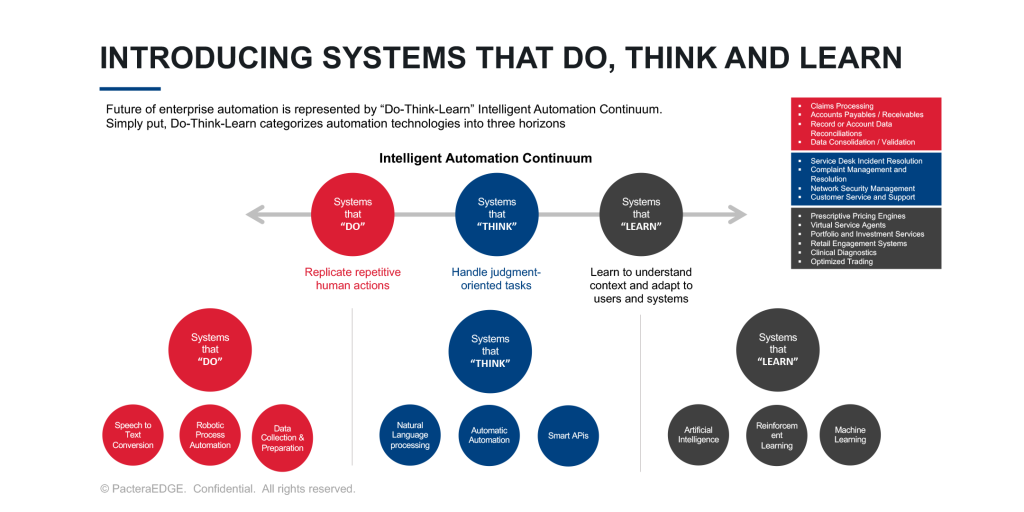
Intelligent automation applies the full complement of AI technologies – not just machine learning but voice intelligence, knowledge cognitive services, and vision intelligence to improve industries ranging from financial services to retail.
Gartner has a similar perspective to mine. In Gartner’s view, RPA is evolving into hyperautomation, in which everything is automated thanks to AI. Gartner sees automation maturing from task automation (where RPA is today) to process automation and then to business operations automation, becoming more sophisticated, as depicted here:
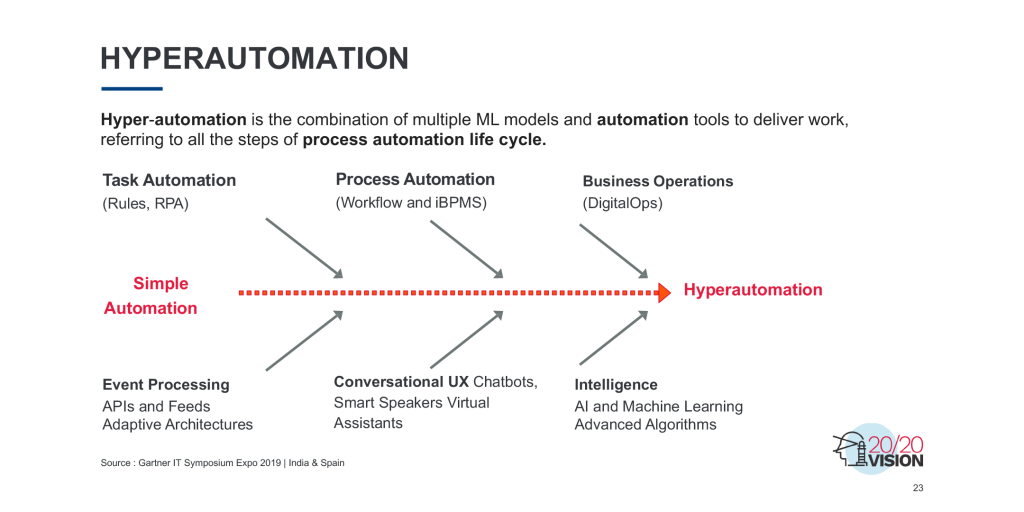
For instance, per this video, rental car companies are exploring how automated expert systems and assistants can be used to rent your car.
In fact, the rise of hyperautomation is one of the biggest strategic technology trends according to Gartner. One of the reasons for the uptake of hyperautomation is the emergence of the “everything customer” who wants to be serviced from every device at all times in a seamless manner. When customers can be serviced across multiple devices and channels flawlessly, people enjoy a more seamless customer experience befitting their expectations.
The ultimate evolution of hyperautomation occurs when machines can act autonomously, meaning they become so intelligent that they require zero human intervention:
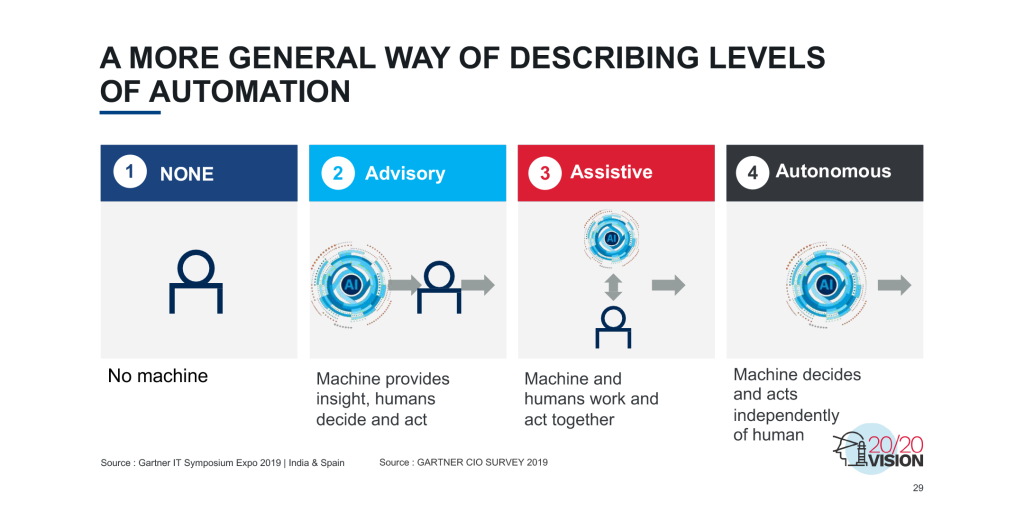
But we are a long way off from this level of maturity.
A number of software companies are quickly driving RPA toward intelligent automation. They include Blue Prism, UI Path, BizRobo, and NICE. Here is how we view them at Centific:
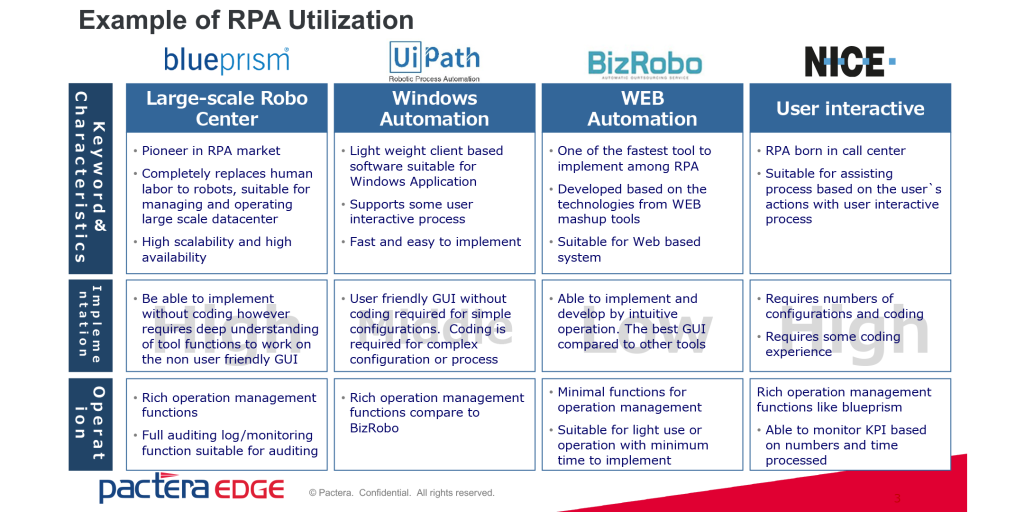
These businesses are important. Industries need them to accelerate the uptake of RPA and its evolution into intelligent automation.
A Measured Approach
But implementing RPA requires more than selecting a software firm. At Centific, we’ve helped a number of companies apply smarter forms of RPA (beyond the pharmaceutical example cited above). We suggest taking a measured approach to adopting RPA, like so:
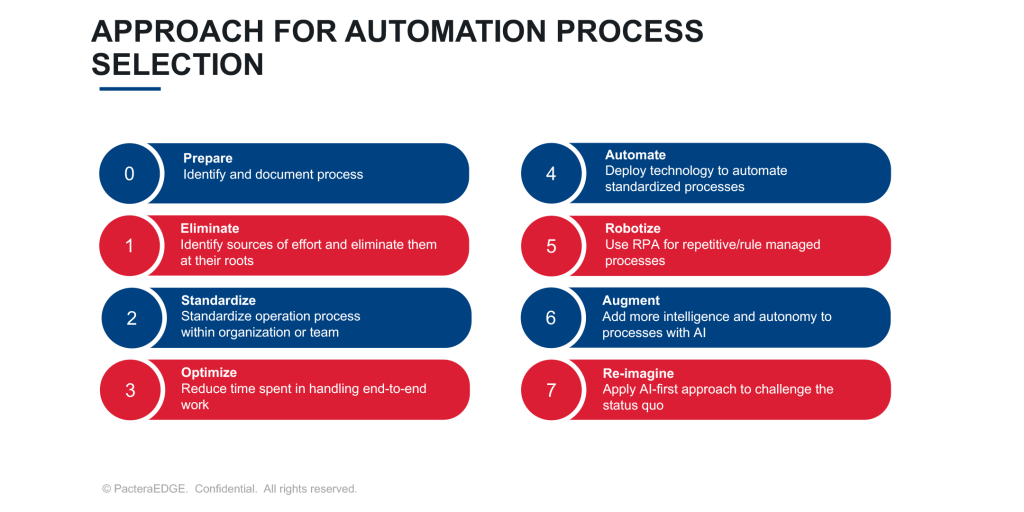
As you can see from the above diagram, everything starts with identifying what processes need to be automated and understanding an approach for doing so. Note that we don’t even mention RPA until Step 5. RPA is not a technology looking for a solution. It’s a technology that needs to make a business better, which is why it’s so important to understand the business need and areas for process improvement first.
Also note that we don’t mention AI until Step 7. We think it’s important to crawl before you walk. Get comfortable first with using RPA to automate processes. AI is like an additive to your engine fuel: it will accelerate your velocity. But you first need to get in motion.
Pact.AI Can Help
Centific partners with major brands to apply RPA and intelligent automation. We call it PactAI. With Pact.AI, Centific provides a complete end-to-end portfolio of data science and data engineering services, AI application enablement, AI solution accelerators, advanced AI frameworks, and end-to-end delivery that will establish, elevate and enable your AI product vision. Centific is helping clients in high tech, banking/financial services/insurance, telecom, retail, consumer packaged goods, manufacturing, and healthcare solve various business challenges with AI. Contact us to learn more.
